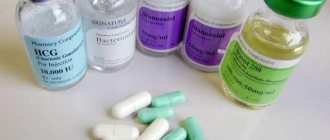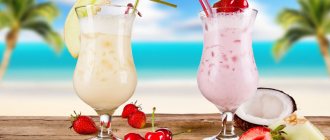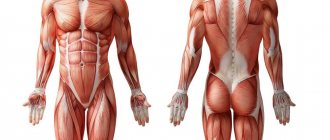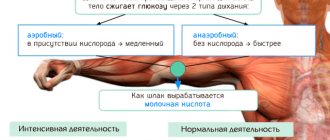Energy processes in muscle[edit | edit code]
The figure shows the predominant sources of energy during exercise. Sources of energy for the formation of ATP
Naturally, energy is required to perform muscle movement. In the human body there are different sources of energy, which are sequentially turned on one after another. Let's look at each of them.
ATP[edit | edit code]
The universal source of energy in a living organism is the ATP molecule, which is formed in the Krebs citrate cycle. Under the action of the enzyme ATPase, the ATP molecule is hydrolyzed, detaching the phosphate group in the form of orthophosphoric acid (H3PO4), and converted into ADP, releasing energy.
ATP + H2O = ADP + H3PO4 + energy
The head of the myosin bridge, when in contact with actin, has ATPase activity and, accordingly, the ability to break down ATP and obtain the energy necessary for movement.
The amount of ATP contained in the muscle is sufficient to perform movements within the first 2-5 seconds.
Creatine phosphate[edit | edit code]
The supply of ATP molecules in the muscle is limited, so energy consumption during muscle work requires its constant replenishment, this occurs due to creatine phosphate. Creatine phosphate has the ability to detach a phosphate group and become creatine by attaching a phosphate group to ADP, which is converted to ATP.
ADP + creatine phosphate = ATP + creatine.
This reaction is called the Lohmann reaction. This is why creatine is of great importance in bodybuilding.
It should be noted that creatine is effective only when performing anaerobic (strength) exercises, since creatine phosphate is enough for about 2 minutes of intense work, then other energy sources are connected. Accordingly, in athletics, taking creatine as a supplement to increase athletic performance is ineffective.
The reserves of creatine phosphate in the fiber are not large, so it is used as an energy source only at the initial stage of muscle work, until other more powerful sources are activated - anaerobic and then aerobic glycolysis. At the end of the muscle work, the Lohmann reaction goes in the opposite direction, and creatine phosphate reserves are restored within a few minutes.
ENERGY STORAGE
Energy is stored in the chemical bonds of carbohydrates, fats and proteins
Squirrels
The chemical energy of proteins , as a source of physical activity, is NOT used immediately. The primary suppliers of energy from chemical bonds are fats and carbohydrates.
Fats
Fats are converted into fatty acids and used by the body:
- in various synthesis processes;
- as a source of energy.
Excess fatty acids in the form of triglycerides accumulate mainly in adipose tissue. And also, partially, in the muscles. There are no limits to fat accumulation. Fat reserves are one hundred or more times greater than the energy reserves of carbohydrates.
Carbohydrates
Carbohydrates are converted into glucose and other simple sugars. These simple sugars are converted into glucose, which can be used:
- in synthesis processes;
- as a source of energy.
Excess glucose molecules are incorporated into glycogen molecules, which accumulate in the liver and muscle tissue
Glycogen
The amount of glycogen that can be stored in an adult is about 100 g in the liver and 375 g in the muscles. Aerobic training can increase muscle glycogen storage levels by up to five times.
Excess carbohydrates, exceeding the level necessary for maximum filling of potential glycogen depots, are converted into fatty acids and accumulated in adipose tissue.
Compared to any protein or carbohydrate, fats more than double the amount of energy measured in kilocalories. Therefore, fats are an effective means of storing energy while minimizing body weight.
The energy of stored glycogen or fat is stored in the chemical bonds of these substances
Creatine phosphate (CrP), or phosphocreatine
Another form of energy storage that comes from the chemical bonds of food products. The body synthesizes creatine phosphate and stores small amounts in the muscles.
Energy metabolism of skeletal muscles[edit | edit code]
Source:
Sports Encyclopedia of Life Support Systems. Editor
: Zhukov A.D.
Ed.
: Unesco, 2011.
Alactate mechanisms[edit | edit code]
CP provides a supply of phosphate energy for the resynthesis of ATP from ADP upon the onset of contractile activity (Fig. 3):
CP + ADP Creatine kinase K + ATP (1)
At rest, muscle fibers increase the concentration of CP up to five times more than ATP. At the beginning of contraction, when the concentration of ATP begins to fall and ADP to increase due to the acceleration of ATP decomposition, mass activity promotes the formation of ATP from CP.
Although the formation of ATP from CP occurs rapidly, requiring one single enzymatic reaction (1), the amount of ATP that can be produced from this process is limited by the initial concentration of CP. Muscle fibers also contain myokinase, which catalyzes the formation of one molecule of ATP and one molecule of AMP from two molecules of ADP. ATP and CP together can provide maximum force within 8-10 seconds. Thus, the energy obtained from the phosphagen system is used for short bursts of maximal muscle activity required in track and field athletics (100 m dash, shot put or weight lifting).
Glycolysis[edit | edit code]
Although metabolism through the glycolytic pathway produces only a small amount of ATP from each unit of glucose digested, it can rapidly synthesize large amounts of ATP if sufficient enzymes and substrate are present. This process can also occur in the absence of oxygen:
Glucose anaerobic rapid glycolysis 2 ATP + 2 lactate (2)
Glucose for glycolysis comes either from the blood or from glycogen stores. When glycogen is the starting material, three ATP molecules are formed from one unit of glucose consumed as a result of phosphorolytic glycogenolysis. As muscle activity becomes more intense, more and more ATP is required to break down muscle glycogen anaerobically, and lactic acid production increases accordingly. Anaerobic glycolysis can provide energy for 1.3-1.6 minutes of maximal muscle activity.
The formation of lactic acid lowers the pH level in muscle fibers. This interferes with the action of enzymes and causes pain if the removal of lactic acid is too slow compared to its formation.
Oxidative phosphorylation[edit | edit code]
Rice. 3. Metabolic pathways for ATP synthesis used during muscle contraction and relaxation. While anaerobic degradation of CP and glycolysis occur in the cytosol, oxidative phosphorylation takes place in the mitochondria. Source: Vander et al. (1990) Main article:
Oxidative phosphorylation
At moderate levels of exercise, such as running a 5000m race or running a marathon, most of the ATP used for muscle contraction is produced by oxidative phosphorylation. Oxidative phosphorylation allows the release of much more energy from glucose compared to anaerobic glycolysis alone:
Glucose + O2-> 38 ATP + CO2+ H2O. (3)
Fats are catabolized only through oxidative mechanisms, which releases a lot of energy. Amino acids can also be metabolized in this way. The three metabolic pathways for the production of ATP for muscle contraction and relaxation are shown in Fig. 3.
During the first 5~10 minutes of moderate physical activity, the main fuel consumed is muscle glycogen. Over the next 30 minutes, blood-borne substances become dominant; Blood glucose and fatty acids contribute approximately equally to muscle oxygen consumption. After this period, fatty acids become increasingly important. It is important to highlight the interaction between anaerobic and aerobic mechanisms in ATP production during exercise. The contribution of anaerobic ATP production is greater during short-term, high-intensity exercise, whereas during longer-term, low-intensity exercise, aerobic metabolism predominates.
Recovery and oxygen debt[edit | edit code]
After the physical activity is over, oxygen absorption still remains above normal (table). Recently, the term “excessive oxygen consumption after exercise” has also been used to refer to oxygen debt. Levels are initially very high while the body replenishes CP and ATP, returning stored oxygen to the tissues, and then consumption is at a lower level for another hour while lactic acid is removed. Therefore, the early and last phases of oxygen debt are called alactic and lactate oxygen debt, respectively. An increase in body temperature also indicates a higher metabolic rate and increased oxygen consumption.
The longer and more intense the physical activity, the longer it takes to recover. For example, recovery from complete depletion of muscle glycogen often takes several days, rather than the seconds, minutes, or hours required to restore CP and ATP stores and remove lactic acid. High-intensity physical activity likely causes microtrauma to muscle fibers, and their recovery takes some time.
Components of oxygen debt. After prolonged, strenuous exercise, breathing remains above normal to meet the increased oxygen demand
| Component | Explanation |
| 1 | Restoration of oxygen reserves in tissues (about 1 l) |
| 2 | Restoring levels of creatine phosphate and other energy-rich phosphates (about 1-1.5 L) |
| 3 | Removal of lactic acid by gluconeogenesis and other routes (up to 12 l) |
| 4 | Stimulation of metabolism due to increased adrenaline levels (about 1 l) |
| 5 | Additional oxygen consumption in the respiratory muscles and heart (about 0.5 l) |
| 6 | General increase in metabolism due to higher body temperature* |
Q10 - A 10°C increase in temperature can double the metabolic rate if cells can cope with such temperature changes
NUTRIENT ENERGY METABOLISM
The accumulation of nutrients containing energy - carbohydrates (glucose), proteins (amino acids) and fats (fatty acids) is a single process.
Excess of these substances accumulates in the form of fats
Glucose can be used to synthesize amino acids, and some amino acids can be used to synthesize glucose.
However, these processes lead to energy consumption. Thus, 5% of energy is lost when glucose is stored as glycogen in the muscles instead of being directly used to produce ATP. This figure increases to 28% when glucose is converted into fatty acids for storage.
The energy systems that use these nutrients do not work sequentially, one after another (first the ATP-CrP system, then the anaerobic glycolysis system, and finally aerobic metabolism). And they turn on at the same time. And their contribution varies depending on:
- presence of oxygen;
- accumulation level;
- level of motor activity.
Thus, the presence of oxygen affects which substrate is used to obtain energy. 8.2 ATP molecules are produced per fatty acid carbon atom. And per carbon atom of a glucose molecule, only 6.2 ATP molecules are produced.
When oxygen is limited, glucose is the preferred source for aerobic metabolism. And the only one - for anaerobic oxidation.
Hormonal changes, as a result of exercise and diet, significantly affect energy flows
Fatty acids produce energy through the aerobic system. But the utilization of fatty acids depends on the simultaneous flow of carbohydrates in the energy pathways to regenerate intermediates in the Krebs cycle.
Without adequate amounts of dietary carbohydrates, fatty acids are transferred to another metabolic pathway. And instead of ATP, fatty acids produce ketones. Only a few tissues, such as the brain, can use ketones for energy production. If carbohydrate stores are low, ketones can increase and cause metabolic imbalance and fatigue.
Muscle growth from a physiological point of view
When performing strength exercises, microscopic tears form in the fibers. Within 24 hours after the end of the session, the body sends nutrients to the site of damage and produces growth hormones. This helps to “heal” the microtear, forming new tissue in its place. So, gradually the muscle increases in volume and becomes stronger.
The restoration and growth of muscle is called hypertrophy.
Phosphocreatine is a creatine system.
Creatine
Phosphocreatine is a chemical compound that has a high-energy phosphate bond that can be hydrolyzed to provide energy and resynthesize ATP. This happens within a very short time. Therefore, all the energy stored in the muscles is available almost instantly for muscle contraction, as is the energy stored in ATP.
Do you want to help the project? Disable AdBlock, so we can earn income from displaying advertising.
When performing short and fast movements, be it a sprint or a barbell snatch, ATP is broken down into ADP, resulting in ATP resynthesis with the help of creatine phosphate. This method is the fastest and easiest way to obtain energy for muscle contraction. This energy source can provide muscle contraction for about 5 seconds, since muscle cells store small amounts of ATP and creatine phosphate. This energy system operates without oxygen and is accordingly called the anaerobic method of energy production.
In this way, energy from the ATP-phosphocreatine system (stored in the muscles) is used to produce the shortest possible bursts of muscle strength.
Basics
The immediate source of energy for muscle function is adenosine triphosphate, or ATP.
. This substance is a nucleotide, similar to those that make up human DNA.
This substance contains three fragments of phosphoric acid. When one of them is split off from ATP, ADP (adenosine diphosphate) is obtained and a lot of energy is released, which goes to muscle work.
Then ADP, using the energy released during the processing of nutrients, is restored back into ATP.
How to lose weight by playing sports
Have you decided to take up fitness to get rid of extra pounds? Learn how to eat, exercise and lose weight.
Bad habits and muscle growth
Smoking has a negative effect on muscle fiber hypertrophy:
- Tar and nicotine interfere with normal protein synthesis.
- Tobacco smoke constricts blood vessels, which impairs the delivery of nutrients to damaged muscles.
- Smoking impairs the functioning of the cardiovascular and respiratory systems, which not only threatens serious health problems, but also interferes with performing strength training exercises with weights.
Alcohol causes no less harm to the body than smoking tobacco:
- Ethyl alcohol inhibits muscle synthesis.
- Frequent use reduces the production of male sex hormones.
- Alcohol has a toxic effect on all body systems. Because of this, there is a decrease in the athlete’s strength capabilities, a slowdown in recovery processes in the muscles, a deterioration in overall well-being, and a decrease in energy and motivation.
What is aerobic metabolism
This process allows you to generate large amounts of energy needed for long-term loads
. During this process, oxygen is used to convert nutrients.
The aerobic metabolic system is slower than the anaerobic metabolic system because it requires blood to deliver oxygen-rich blood to the muscles, where ATP is produced.
But aerobic metabolism is used when endurance
- that is, during a load
of low intensity
, but long-term.
Afterword
Today we looked at nutrition for gaining muscle mass. Well, as we sorted it out, we were carried away, as usual, into theory, and there we dug up to the tomatoes :). But seriously, in this article we have done serious preparatory work regarding understanding the issues of mass gain; all that remains is to find out: what products should be purchased and how to competently draw up a nutrition plan for mass. This is exactly what we will do in the second part, so we are far from diverging and are waiting for the second coming! See you soon!
PS. How do you eat for weight?
P.P.S. second part of the note
With respect and gratitude, Dmitry Protasov.
Muscle Growth Factors
Effective formation of new tissues to replace damaged ones is a complex process that depends on several “parameters.” Let's list them:
- Genetic features of muscle structure (thickness of thread-like structures, ratio of fast and slow fibers, number of capillaries and nerve endings).
- Athlete body type. It is believed that a person with any body type can achieve success in bodybuilding, but mesomorphs are most adapted to mass-gaining training.
- Complete rest. In order for a muscle damaged during strength training to recover, you need to give it at least a day of rest and quality eight-hour sleep.
- Calorie diet. To form new fibers, the body requires proteins, fats, carbohydrates and vitamins. All this should be contained in abundance in a bodybuilder’s diet.
- Proper strength training. Muscles quickly adapt to loads. Therefore, each lesson should be a little harder than the previous one. In addition, you should change the program frequently.
Age also affects the body's ability to build muscle size. This is due to the amount of hormones produced. After 30 years, testosterone secretion gradually decreases every year. Therefore, athletes under 30 progress much faster than their older colleagues.











